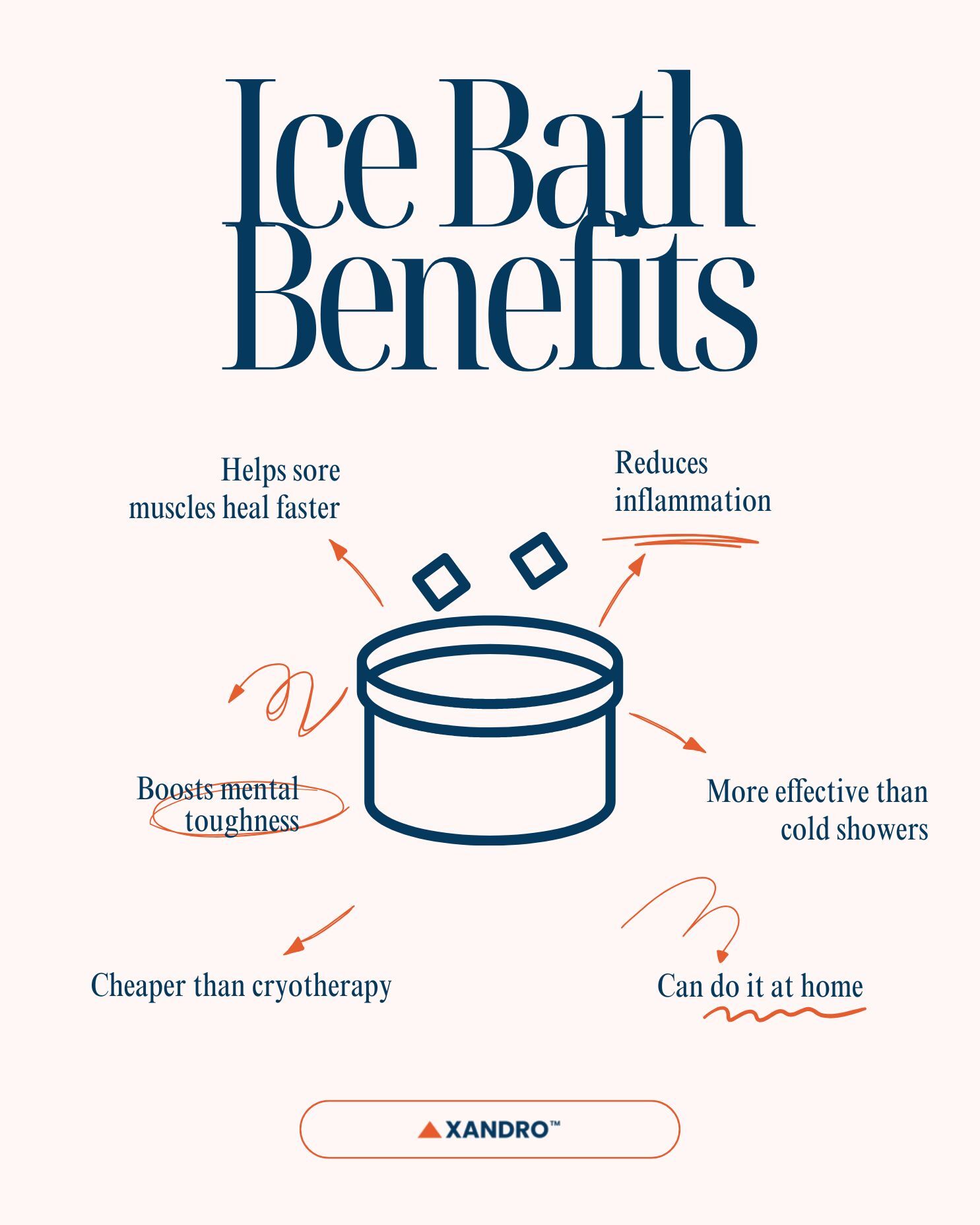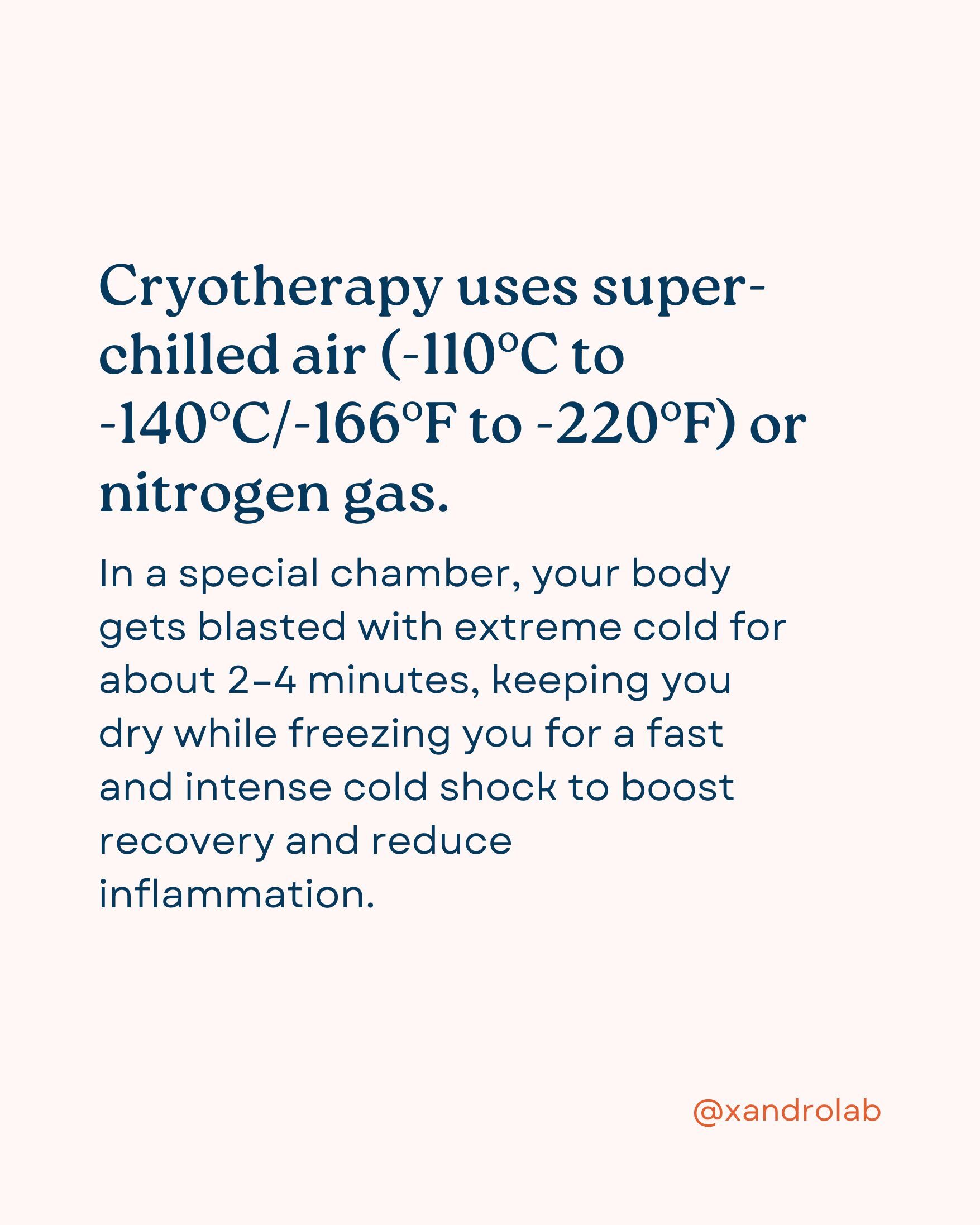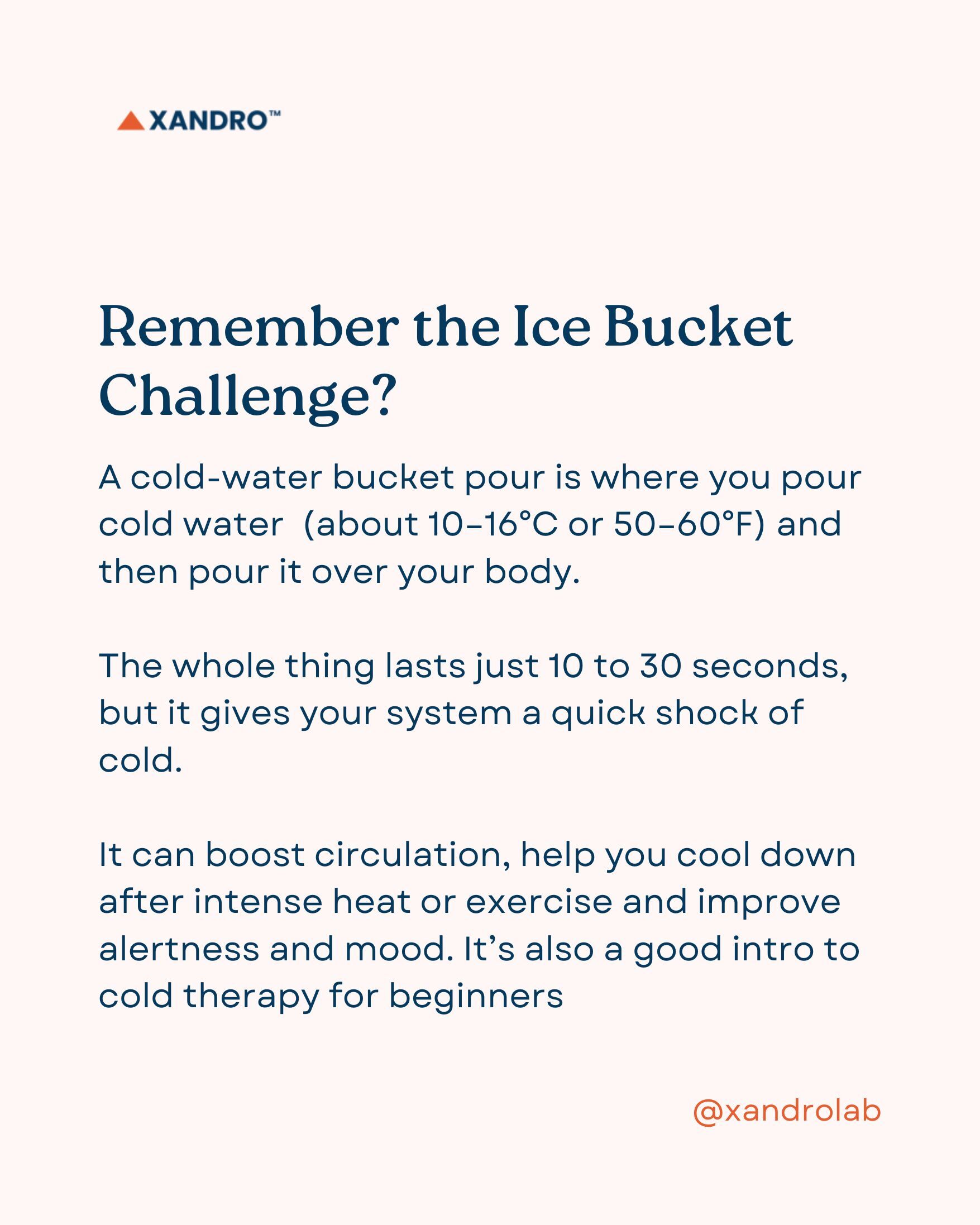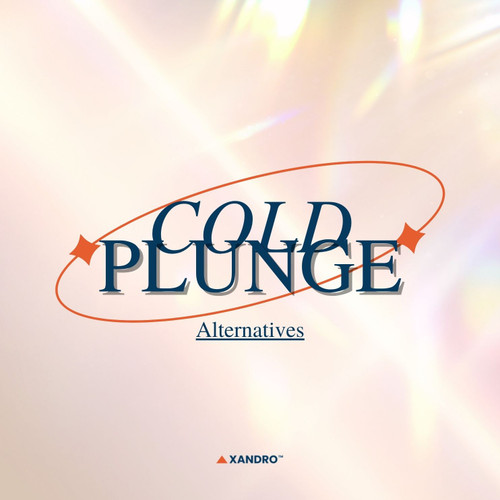12 Types of Cold Exposure Therapy
1st Jul 2025
What are the Options for Cold Therapy?
Cold exposure therapy has moved from being an unusual practice to a mainstream health trend, with many people using it to boost recovery, reduce inflammation, improve mood and even speed up metabolism.
While ice baths are the most well-known method, there are plenty of other ways to experience the benefits of cold therapy, some more intense, others more beginner-friendly.
Here’s a detailed look at 12 different cold exposure methods, including how they work, their benefits and how to try them safely.
Jump there now:
- Ice Baths
- Cold Showers
- Cold Baths
- Cryotherapy
- Cold Water Swimming
- Cold Air Exposure
- Contrast Therapy
- Cold-Water Bucket Pour
- Cold-Water Face Plunge
- Snow Plunge
- Cooling Vests
- Cold Compresses or Ice Packs
Is There Scientific Proof that Cold Plunges Work?
There is evidence suggesting cold-water immersion may help reduce the level of exercise-induced muscle damage after physical exercise. It does this by triggering various responses in your body, including lowering your metabolic activity, altering your hormones and blood flow and activating your immune system.
While studies often are undertaken on small groups and often on one gender, cold-water immersion has generally been found to reduce or transform body adipose tissue, reduce insulin resistance and improve insulin sensitivity. This may also help protect against metabolic diseases and cardiovascular obesity.
Before you continue reading more, check out our article where we talk all about what cold exposure is and cold exposure benefits.
What is an Alternative to a Cold Plunge?
1. Ice Baths (Cold Water Immersion)
An ice bath is exactly what it sounds like. You sit in a tub of cold water (usually between 10–15°C/50–59°F) for 2 to 15 minutes. This full-body cold exposure shocks your system, helping with muscle recovery, reducing inflammation, and even toughening you up mentally.
Why Try Ice Baths?
Compared to cold showers, ice baths are more intense, making them great for athletes or anyone looking for deeper recovery benefits. They’re also cheaper and easier to access than cryotherapy (which requires special clinics and can cost a lot).
Pros:
- Better recovery: Helps sore muscles heal faster.
- Reduces inflammation: Cold constricts blood vessels, then flushes fresh blood when you warm up.
- Boosts mental toughness: Getting through the discomfort builds resilience
- More effective than cold showers: Full-body immersion triggers stronger benefits.
Cons:
- Uncomfortable at first: Your body needs time to adjust.
- Takes effort to set up: You’ll need a lot of ice (unless you have a chiller).
- Not for everyone: People with heart conditions or poor circulation should check with a doctor first.
How to start an ice bath safely:
- Begin with warmer water (around 15°C (59°F) and short sessions (3–5 minutes).
- Gradually lower the temperature and increase the time as you get used to it.
- Always have someone nearby when starting out and exit if you feel extreme discomfort.

2. Cold Showers
This is the most common DIY cold plunge method. Cold showers are the easiest way to start cold exposure therapy. Simply turn the shower to cold (10–15°C/50–59°F) for 30 seconds to 5 minutes.
Why try Cold Showers?
It’s cold exposure at home! No special equipment is needed, just your regular shower. It’s a gentle introduction to cold therapy, helping with circulation, alertness and mental toughness.
Just keep in mind that the water temperature isn’t as controlled as an ice bath and it may not provide the same deep muscle recovery benefits. The benefits are also not as great as longer cold exposure, but it’s great for an energy boost in the morning.
How to make a cold shower easier:
- Start with a warm shower, then switch to cold for the last 30 seconds.
- Gradually increase the cold exposure time over days or weeks, trying 1 minute and then 2.
- Focus on deep breathing to stay calm during the shock.
- Focus on major areas, such as your back, legs and arms where big muscles and blood vessels are.
Cold Showers vs. Ice Baths – Which is Better?
|
Cold Showers |
Ice Baths |
|
Easy and quick: Just turn the knob. |
More setup: Need ice or a cold plunge. |
|
Gentler introduction: Good for beginners. |
More intense: Better for deep recovery. |
|
Short-term energy boost: Wakes you up fast. |
Longer-lasting benefits: Reduces muscle soreness better. |
Best for:
- Cold showers: Daily habit, mental toughness, quick energy.
- Ice baths: Serious recovery after workouts, deeper cold benefits.
3. Cold Baths
How do you make homemade cold-water therapy? Another method is a cold bath, which involves sitting in cold water — usually between 10–15°C (50–59°F) — for a few minutes. They help your body recover, reduce soreness and build mental toughness.
Cold baths are stronger than cold showers and more affordable than cryotherapy. Athletes love them, but anyone can benefit. Most people panic at first when sitting in the bath, which is totally normal. After a minute, though, it gets easier. Keep it simple, stay safe, and don’t push past your limit.
Top Benefits:
- Faster recovery: Great for sore muscles.
- Less inflammation: Cold shrinks blood vessels, then sends in fresh blood when you warm up.
- Mental boost: Builds resilience.
- More effective than cold showers: Full-body cold means more benefits.
How to Start a Cold Bath:
- Begin with just cold water — no ice — and short dips (3–5 mins)
- Lower the temp and increase time slowly
- Wear a long-sleeved top and shorts to keep warm
- Have someone with you, especially the first time
- Focus on deep breathing or talk to a friend to stay calm
- Dip your face a few times — it helps your body adjust faster
4. Cryotherapy (Whole-Body Cryo)
Imagine stepping into a walk-in freezer — but 10x colder (-110°C to -140°C/-166°F to -220°F). You stay in for just 2–4 minutes and your whole body gets blasted with extreme cold.
Unlike ice baths (wet cold) or cold showers (water-based), cryotherapy uses super-chilled air or nitrogen gas in a special chamber, keeping you dry while freezing you to the core.
Why try Cryotherapy?
It’s the fastest and most intense cold exposure method, potentially reducing inflammation and boosting recovery more than other techniques. It also boosts endorphins (your feel-good hormones), so you may get a mood lift.
Cryotherapy, however, can be expensive as it requires a specialised facility. This makes it not easily accessible for most people, and there’s also a risk of frostbite if not done properly.
How to do Cryotherapy safely:
- Visit a licensed cryotherapy centre, such as Cryo Fit and Orchard Health Clinic in Singapore.
- Wear minimal, dry clothing (shorts, gloves, socks).
- Start with shorter sessions (1–2 minutes) before working up to the full time.
- If you feel dizzy or too numb, stop immediately.
Who Should Avoid Cryotherapy?
- People with heart problems, high blood pressure, or nerve issues.
- If you have Raynaud’s syndrome (poor circulation in fingers/toes).
- Pregnant women.
Can cold plunging help you lose weight? Read all about it in our post.

5. Cold Water Swimming (Open Water Plunges)
Cold water swimming means taking a dip in natural chilly waters (lakes, oceans, or rivers below 15°C/59°F). Unlike ice baths or cryotherapy, you're moving in the cold, not just sitting still.
How long?
- Beginners: 1–5 minutes
- Seasoned swimmers: Up to an hour (with proper acclimation)
Why try Cold Water Swimming?
- Boosts mood and mental health: The combo of cold and nature is magic for stress relief.
- Better than static cold therapy: Swimming keeps blood flowing, reducing shock.
- Social and fun: Many do it in groups for motivation (and safety).
- Free & natural: No ice, no machines, just you and the wild.
But be careful:
- Risk of hypothermia: Your body loses heat fast in cold water.
- Drowning danger: Cold shock can make you gasp and panic.
- Unpredictable conditions: Currents, depth and water quality vary.
How to start cold water swimming safely:
- Begin in warmer months and gradually adapt to colder water.
- Always swim with a buddy.
- Wear a bright swim cap for visibility.
6. Cold Air Exposure
This simply means spending time in cold outdoor air (below 10°C/50°F) with minimal clothing.
Why try Cold Air Exposure?
No special setup needed — just step outside. Great for cold-weather activities like winter hiking. It’s just less intense than water-based methods, and effectiveness depends on wind and humidity.
How to do cold air exposure safely:
- Start with short exposures (5–10 minutes).
- Move around to stay warm.
- Watch for signs of frostbite (numb fingers/toes).
7. Contrast Therapy (Hot & Cold Alternating)
Contrast therapy is like giving your body a ‘temperature workout’ by switching between hot and cold water. Think of it as training your blood vessels to open up (with heat) and then tighten up (with cold), which can help improve circulation, reduce soreness and speed up recovery after exercise or injury.
Why Try Contrast Therapy?
- Better Blood Flow: The back-and-forth between hot and cold acts like a pump, pushing blood in and out of muscles, which may help clear out waste products and bring in fresh oxygen and nutrients.
- Faster Recovery: Some studies suggest it works better than just using cold therapy alone, especially for muscle soreness after workouts.
- More Comfortable Than Pure Cold: Since you’re not staying in the cold the whole time, it can be easier to tolerate than an ice bath.
Some athletes do contrast therapy by alternating between going to saunas and cryotherapy centres.
How to Do Contrast Therapy at Home
There are a few different ways to do contrast therapy, depending on what feels best for you:
Option 1 (Simple Shower Method – Good for Beginners)
- Hot Phase: 2 minutes (37–40°C/98–104°F)
- Cold Phase: 30 seconds (10–15°C/50–59°F)
- Repeat: 3–5 times (total time: ~10–15 minutes)
Option 2 (Limb-Specific – Used in Sports Recovery)
- Start with Hot: Soak the sore area (like a leg or arm) in warm water (38–40°C/100–104°F) for 10 minutes.
- Switch to Cold: Move to cold water (8–10°C/46–50°F) for 1 minute.
- Alternate: Go back to hot for 4 minutes, then cold for 1 minute, repeating until you hit 30 minutes total.
8. Cold-Water Bucket Pour
Looking for a fast and simple way to try cold water therapy without jumping into a bath or buying any fancy equipment? The cold-water bucket pour (or the ice bucket challenge that went vital years ago) might be the perfect starting point.
You fill a bucket with cold water (about 10–16°C or 50–60°F) and then pour it over your body. The whole thing lasts just 10 to 30 seconds, but it gives your system a quick shock of cold.
It can boost circulation, help you cool down after intense heat or exercise and improve alertness and mood. It’s also a good intro to cold therapy for beginners.
Why try a Cold-Water Bucket Pour?
- Super simple: All you need is a bucket and access to cold water.
- Quick: Great if you’re short on time or just want a rapid refresh.
- Energising: The sudden cold triggers your body’s fight-or-flight response — it wakes you up, boosts your circulation, and activates your nervous system.
- Great after a sauna or workout: Often used in traditional Finnish sauna routines to cool the body quickly and stimulate recovery.
How to do it:
- Fill a bucket with cold water — add some ice if you want it colder.
- Stand in a safe, non-slip area (like a shower or outside).
- Pour the water over your body — try to go from the shoulders down, or target areas like your back, neck and chest.
- Towel off and warm up afterward if needed.
Since the exposure is short, it won’t give you all the deep recovery benefits of longer cold baths or plunges. Also, since the water runs over your skin instead of surrounding your body, it may not trigger as strong of a physiological response, but it’s still a great way to dip your toes into cold therapy.

9. Cold Water Face Plunge
If you're curious about cold water therapy but don’t feel ready for an ice bath, dunking just your face in cold water is a great place to start. It’s quick, easy and can be done at home using just a bowl and some cold tap water.The cold-water face plunge involves submerging your face (just your face, not your whole head) in a bowl of cold water for about 15 to 30 seconds. You can use regular cold tap water (around 18–19°C/64–66°F) or add a few ice cubes to make it colder.
Why do a Cold-Water Face Plunge?
This simple act can calm your body and mind. It stimulates something called the diving reflex, a natural reaction that slows your heart rate and helps you relax. It also activates the vagus nerve, which is connected to your body’s ‘rest and digest’ system. That means it can help you feel less stressed, reduce anxiety, and even ease inflammation.
What are the benefits of a Cold-Water Face Plunge
- Reduces stress: Helps calm the nervous system
- Lowers heart rate: Good if you’re feeling anxious or overwhelmed
- Reduces puffiness and inflammation: Especially around the face and eyes
- Feels refreshing: A great mental reset or energy boost
- Good for beginners: It’s a gentle intro to cold water therapy
How to do a Cold-Water Face Plunge?
- Fill a bowl with cold water (add ice if you'd like it colder).
- Take a deep breath.
- Submerge your face for 15–30 seconds.
- Repeat 3–5 times with short rests in between.
You can also splash cold water on your face or use a cold compress if you’re not ready for a full plunge.
More Options for a Cold Plunge Alternative
10. Snow Plunge (Rolling in Snow): Burying yourself in snow for 30 seconds to 2 minutes. It’s a fun, dry alternative to ice baths — great in winter climates (though, this means it’s only possible in snowy areas).
11. Cooling Vests: Wearable vests that keep you cool (13–18°C/55–65°F) for 1–3 hours. This is one of the best cold plunge alternatives for people who want mild cold exposure while being active.
12. Cold Compresses or Ice Packs: Apply ice to sore muscles for 15–20 minutes. This method is best for targeted pain relief, not full-body benefits.
Which Is the Best Cold Exposure Method for You To Try?
- Beginners: Start with cold showers or short ice baths.
- Recovery: Ice baths or contrast therapy work best.
- Convenience: Cold showers or face plunges are easiest.
- Extreme cold lovers: Try cryotherapy or cold water swimming.
Final Safety Tips
- Never stay in extreme cold too long.
- Listen to your body! Stop if you feel numbness or dizziness.
- Warm up gradually afterward (avoid hot showers right after ice baths).
Read more about our cold exposure safety tips and how to get started here.
End Note
Cold exposure isn’t about suffering. It’s about pushing your comfort zone safely to gain mental and physical benefits. Start small, stay consistent and find the method that works for you!
Are you based in Singapore and looking for a ‘cold plunge near me’ to start doing cold exposure therapy? Find out where you can go here.Don’t forget to try other methods to improve your health, such as eating whole foods, exercising, getting enough sleep and managing your stress. You can also try taking supplements to boost your health, such as Zinc Picolinate + C to boost your immunity, Joint Recovery or Essential+ Methylated Multivitamin for overall health.
